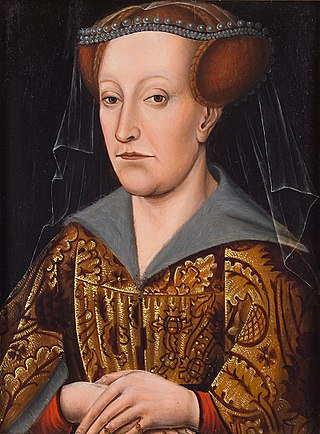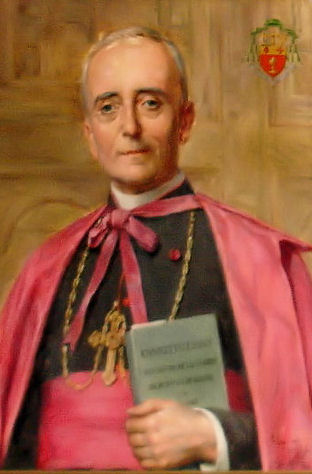Related Research Articles

Philip II the Bold was Duke of Burgundy and jure uxoris Count of Flanders, Artois and Burgundy. He was the fourth and youngest son of King John II of France and Bonne of Luxembourg.

The Seventeen Provinces were the Imperial states of the Habsburg Netherlands in the 16th century. They roughly covered the Low Countries, i.e., what is now the Netherlands, Belgium, Luxembourg, and most of the French departments of Nord and Pas-de-Calais (Artois). Also within this area were semi-independent fiefdoms, mainly ecclesiastical ones, such as Liège, Cambrai and Stavelot-Malmedy.

Charles Martin called The Bold, was the last Duke of Burgundy from the Burgundian cadet branch of House of Valois from 1467 to 1477. He was the only legitimate son of Philip the Good and his third wife, Isabella of Portugal. Appointed as the Count of Charolais upon his birth, Charles vied for power and influence even before succeeding his father. He had a deep rooted rivalry with Louis XI, the King of France, which was the cause to many disputes and events during his life, starting with the War of the Public Weal, a revolt of French vassals under the leadership of Charles.

Mary of Burgundy, nicknamed the Rich, was a member of the House of Valois-Burgundy who ruled a collection of states that included the duchies of Limburg, Brabant, Luxembourg, the counties of Namur, Holland, Hainaut and other territories, from 1477 until her death in 1482.
Duke of Burgundy was a title used by the rulers of the Duchy of Burgundy, from its establishment in 843 to its annexation by the French crown in 1477, and later by members of the House of Habsburg, including Holy Roman emperors and kings of Spain, who claimed Burgundy proper and ruled the Burgundian Netherlands.

The Duchy of Burgundy emerged in the 9th century as one of the successors of the ancient Kingdom of the Burgundians, which after its conquest in 532 had formed a constituent part of the Frankish Empire. Upon the 9th-century partitions, the French remnants of the Burgundian kingdom were reduced to a ducal rank by King Robert II of France in 1004. Robert II's son and heir, King Henry I of France, inherited the duchy but ceded it to his younger brother Robert in 1032.

The Distinguished Order of the Golden Fleece is a Catholic order of chivalry founded in Bruges by Philip the Good, Duke of Burgundy, in 1430, to celebrate his marriage to Isabella of Portugal. Today, two branches of the order exist, namely the Spanish and the Austrian Fleece; the current grand masters are King Felipe VI of Spain and Karl von Habsburg, head of the House of Habsburg-Lorraine, respectively. The Grand Chaplain of the Austrian branch is Cardinal Christoph Schönborn, Archbishop of Vienna.

Philip III the Good ruled as Duke of Burgundy from 1419 until his death in 1467. He was a member of a cadet line of the Valois dynasty, to which all 15th-century kings of France belonged. During his reign, the Burgundian State reached the apex of its prosperity and prestige, and became a leading centre of the arts.

Jacqueline, of the House of Wittelsbach, was a noblewoman who ruled the counties of Holland, Zeeland and Hainaut in the Low Countries from 1417 to 1433. She was also Dauphine of France for a short time between 1415 and 1417 and Duchess of Gloucester in the 1420s, if her marriage to Humphrey, Duke of Gloucester, is accepted as valid.

In the history of the Low Countries, the Burgundian Netherlands or the Burgundian Age is the period between 1384 and 1482, during which a growing part of the Low Countries was ruled by the Dukes of Burgundy. Within their Burgundian State, which itself belonged partly to the Holy Roman Empire and partly to the Kingdom of France, the dukes united these lowlands into a political union that went beyond a personal union as it gained central institutions for the first time.

The hennin was a headdress in the shape of a cone, steeple, or truncated cone worn in the Late Middle Ages by European women of the nobility. They were most common in Burgundy and France, but also elsewhere, especially at the English courts, and in Northern Europe, Hungary and Poland. They were little seen in Italy. It is unclear what styles the word hennin described at the time, though it is recorded as being used in French areas in 1428, probably before the conical style appeared. The word does not appear in English until the 19th century. The term is therefore used by some writers on costume for other female head-dresses of the period.

John II, Count of Nevers was a French noble.

The House of Valois-Burgundy, or the Younger House of Burgundy, was a noble French family deriving from the royal House of Valois. It is distinct from the Capetian House of Burgundy, descendants of King Robert II of France, though both houses stem from the Capetian dynasty. They ruled the Duchy of Burgundy from 1363 to 1482 and later came to rule vast lands including Artois, Flanders, Luxembourg, Hainault, the county palatine of Burgundy (Franche-Comté), and other lands through marriage, forming what is now known as the Burgundian State.

Ferry de Clugny, Cardinal and Bishop of Tournai was a highly placed statesman and ecclesiastic in the service of the Dukes of Burgundy.

John I, Duke of Cleves, Count of Mark. Jean de Belliqueux (warlike), was Duke of Cleves and Count of Mark.

The Diocese of Ghent is a Latin Church ecclesiastical territory or diocese of the Catholic Church in Belgium. It is a suffragan in the ecclesiastical province of the metropolitan Archdiocese of Mechelen-Brussels. The patron of the diocese is Saint Bavo of Ghent.

Frederik of Egmont was count of Buren and Leerdam, Lord of IJsselstein and councilor of Charles the Bold and Maximilian I.

Eugène Victor Marie van Rechem was a Belgian auxiliary bishop of the Diocese of Ghent.

The Burgundian State is a concept coined by historians to describe the vast complex of territories that is also referred to as Valois Burgundy.